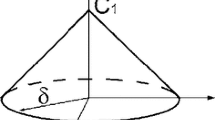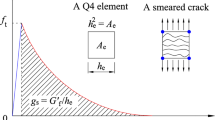Abstract
Dynamic brittle fracture under high-rate loading conditions is analyzed. A new numerical algorithm based on peridynamic approach and structural–temporal model of fracture is used to predict the start of a crack in glassy polymer samples. The results of calculations are compared with available experimental data.



Similar content being viewed by others
REFERENCES
K. Ravi-Chandar and W. G. Knauss, Int. J. Fract. 25, 247 (1984). https://doi.org/10.1007/BF00963460
K. Ravi-Chandar and W. G. Knauss, Int. J. Fract. 26, 141 (1984). https://doi.org/10.1007/BF01157550
G. Irwin, J. Appl. Mech. 24, 361 (1957).
A. J. Rosakis and G. Ravichandran, Int. J. Solids Struct. 37 (1–2), 331 (2000). https://doi.org/10.1016/S0020-7683(99)00097-9
G. Johnson and W. Cook, Eng. Fract. Mech. 21 (1), 31 (1985). https://doi.org/10.1016/0013-7944(85)90052-9
R. Panchadhara and P. A. Gordon, Int. J. Fract. 201 (1), 81 (2016). https://doi.org/10.1007/s10704-016-0124-8
Y. V. Petrov and A. A. Utkin, Sov. Mater. Sci. 25 (2), 153 (1989). https://doi.org/10.1007/BF00780499
Yu. V. Petrov, Dokl. Akad. Nauk SSSR 321 (1), 66 (1991).
Yu. V. Petrov and E. V. Sitnikova, Tech. Phys. 49 (1), 57 (2004). https://doi.org/10.1134/1.1642679
Y. V. Petrov, B. L. Karihaloo, V. V. Bratov, and A. M. Bragov, Int. J. Eng. Sci. 61, 3 (2009). https://doi.org/10.1016/j.ijengsci.2012.06.004
N. A. Kazarinov, V. A. Bratov, and Y. V. Petrov, J. Phys.: Conf. Ser. 653 (1), 012050 (2015). https://doi.org/10.1088/1742-6596/653/1/012050
S. A. Silling, J. Mech. Phys. Solids 48 (1), 175 (2000). https://doi.org/10.1016/S0022-5096(99)00029-0
S. A. Silling, M. Epton, O. Weckner, J. Xu, and E. Askari, J. Elasticity 88, 151 (2007). https://doi.org/10.1007/s10659-007-9125-1
Y. D. Ha and F. Bobaru, Int. J. Fract. 162 (1–2), 229 (2010). https://doi.org/10.1007/s10704-010-9442-4
M. L. Parks, D. J. Littlewood, J. A. Mitchell, and S. A. Silling, Peridigm Users’ Guide, Tech. Report SAND2012-7800 (Sandia Nat. Lab., 2012).
T. Nakamura, C. F. Shih, and L. B. Freund, Int. J. Fract. 27, 229 (1985). https://doi.org/10.1007/BF00017970
E. Madenci and E. Oterkus, Peridynamic Theory and Its Applications (Springer, New York, 2014).
Handbook of Peridynamic Modeling, Ed. by F. Bobaru, J. T. Foster, P. H. Geubelle, and S. A. Silling (CRC, Boca Raton, 2016).
Y. V. Petrov and N. F. Morozov, J. Appl. Mech. 61, 710 (1994). https://doi.org/10.1115/1.2901518
ACKNOWLEDGMENTS
The authors are grateful to Dr. E. Oterkus, professor at the University of Strathclyde and the head of the Peridynamic Research Center (Glasgow, United Kingdom) for support in the development of the numerical peridynamic model used in this study, as well as to I.V. Mikhnovich for cooperation in writing the software code.
Funding
This study was supported by the Russian Foundation for Basic Research (project nos. 20-01-00291 and 19-31-60037). Sections 1 and 3 were written by Yu.V. Petrov under the support of the Russian Science Foundation, project no. 17-11-01053.
Author information
Authors and Affiliations
Corresponding author
Ethics declarations
The authors declare that they have no conflicts of interest.
Additional information
Translated by N. Wadhwa
Rights and permissions
About this article
Cite this article
Ignatiev, M.O., Petrov, Y.V. & Kazarinov, N.A. Simulation of Dynamic Crack Initiation Based on the Peridynamic Numerical Model and the Incubation Time Criterion. Tech. Phys. 66, 422–425 (2021). https://doi.org/10.1134/S1063784221030099
Received:
Revised:
Accepted:
Published:
Issue Date:
DOI: https://doi.org/10.1134/S1063784221030099




